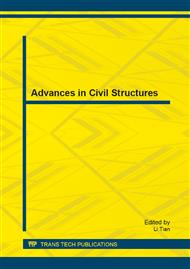[1]
Gara. Fabrizio, Leoni. Graziano, Dezi. Luigino. A beam finite element including shear lag effect for the time-dependent analysis of steel-concrete composite decks [J]. Engineering Structures, 2009, 31(8): 1888-(1902).
DOI: 10.1016/j.engstruct.2009.03.017
Google Scholar
[2]
Gara. Fabrizio, Ranzi. Gianluca, Leoni. Graziano. Partial interaction analysis with shear-lag effects of composite bridges: A finite element implementation for design applications [J]. Advanced Steel Construction, 2011, 7(1): 1-16.
DOI: 10.18057/ijasc.2011.7.1.1
Google Scholar
[3]
Gara. F, Ranzi. G, Leoni.G. Simplified method of analysis accounting for shear-lag effects in composite bridge decks[J]. Journal of Constructional Steel Research , 2011, 67(10): 1684-1697.
DOI: 10.1016/j.jcsr.2011.04.013
Google Scholar
[4]
Jianguo Nie, Faxiong Li, Jiansheng Pan. Practical design method for steel-concrete composite beam considering shear lag effect [J]. Engineering Mechanics, 2011, 28(11): 45-51.
Google Scholar
[5]
Qizhi Luo. Geometric nonlinear analysis of curved box continuous girders considering shear lag effect [J]. Advanced Materials Research, 2011, 243-249: 1811-1816.
DOI: 10.4028/www.scientific.net/amr.243-249.1811
Google Scholar
[6]
Yanling Zhang, Yunsheng Li, Wenyu Ji. A closed-form solution of load effect and study of shear lag effect for simple steel-concrete composite box beam [J]. Journal of Shijiazhuang Railway Institute, 2009, 22(1): 5-14.
Google Scholar
[7]
Qi Kang, Lin Ma, Yue Xu. Influence of Shear Lag and Shear Deformation on the Vibration of Thin-Wall Box-Girder [J]. Journal of Jiangnan University(Natural Science Edition), 2009, 8(1): 94-97.
Google Scholar
[8]
Jianxin Liu, Lin Ma, Qingan Hu. The Research of Analysis Method of Shear Lags Effect on Forced Vibration of Thin- wall Box girder [J]. Journal of Zhengzhou University (Engineering Science), 2008, 29(3): 122-125.
Google Scholar
[9]
Yongjian Zhang, Pingming Huang. Study on Nonlinear PID Controller for TCSC in Multi Machine System [J]. Journal of Zhengzhou University (Engineering Science), 2007, 28(1): 51-55.
Google Scholar
[10]
Yanan Gan, Guangchun Zhou. Analysis of free vibration characteristics of thin-walled box girder based on energy variation principle[J]. China Journal of Highway and Transport, 2007, 20(1): 73-78.
Google Scholar
[11]
Genhui Wang, Yanan Gan. Research Analysis of Natural Vibration Characteristics on Continuous Box Girder [J]. JOURNAL OF LANZHOU JIAOTONG UNIVERSITY (Natural Sciences), 2003, 22(1): 40-43.
Google Scholar
[12]
Jingjing Qi, Lizhong Jiang. Effects of interface slip, vertical uplift and shear deformation on dynamic behavior of steel-concrete composite continuous beams [J]. Journal of Central South University (Science and Technology), 2010, 41(6): 2334-2343.
Google Scholar
[13]
Jingjing Qi, Lizhong Jiang. Effects of interface slip and semi-rigid joint on elastic seismic response of steel-concrete composite frames [J]. Journal of Central South University of Technology, 2010, 17(6): 1327-1335.
DOI: 10.1007/s11771-010-0638-6
Google Scholar
[14]
Ayoub A. A force-based model for composite steel-concrete beams with partial interaction [J]. Journal of Constructional Steel Research, 2005, 61(3): 387−414.
DOI: 10.1016/j.jcsr.2004.08.004
Google Scholar
[15]
Ranzi G, Zona A. A steel-concrete composite beam model with partial interaction including the shear deformability of the steel component [J]. Engineering Structures, 2007, 29(11): 3026−3041.
DOI: 10.1016/j.engstruct.2007.02.007
Google Scholar
[16]
Feifei Sun, Oreste S. Bursi, A.M. ASCE. Displacement-Based and Two-Field Mixed Variational Formulations for Composite Beams with Shear Lag[J]. JOURNAL OF ENGINEERING MECHANICS, 2005, 131(2): 199-210.
DOI: 10.1061/(asce)0733-9399(2005)131:2(199)
Google Scholar
[17]
Wangbao Zhou, Lizhong Jiang, Zhijie Liu. Closed-Form Solution for Shear Lag Effects of Steel-Concrete Composite Box Beams Considering Shear Deformation and Slip[J]. Journal of Central South University , 2012, 19(9): 2650-2655.
DOI: 10.1007/s11771-012-1366-x
Google Scholar
[18]
Wangbao Zhou, Lizhong Jiang, Zhijie Liu. Closed-form Solution to Thin-Walled Box Girders Considering the Effects of Shear Deformation and Shear Lag[J]. Journal of Central South University , 2012, 19(10): 2976-2982.
DOI: 10.1007/s11771-012-1323-8
Google Scholar


